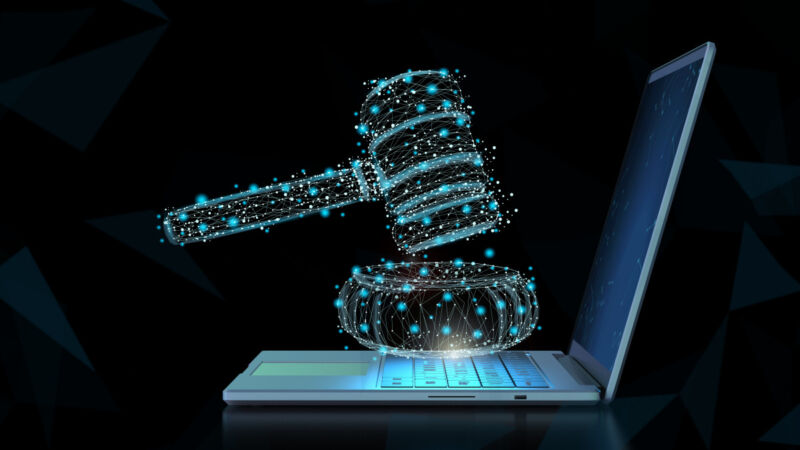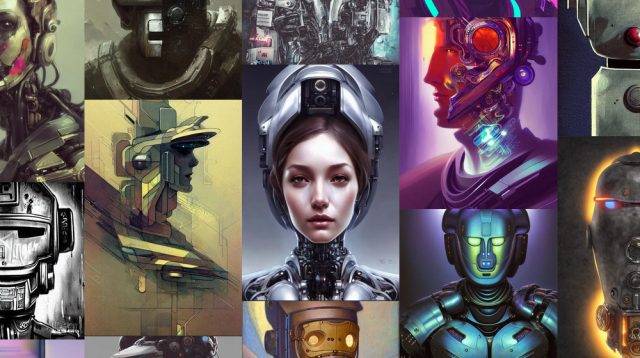Purchase Diffusion goes to courtroom —
Swimsuit seeks damages from Steadiness AI, Midjourney, and DeviantArt.
Benj Edwards –

Lengthen / A pc-generated gavel hovers over a pc private pc.
Some artists private begun waging a trustworthy combat towards the alleged theft of billions of copyrighted footage used to arrange AI artwork mills to breed new kinds with out compensating artists or asking for consent.
A neighborhood of artists represented by the Joseph Saveri Legal guidelines Firm has filed a US federal class-action lawsuit in San Francisco towards AI-art companies Steadiness AI, Midjourney, and DeviantArt for alleged violations of the Digital Millennium Copyright Act, violations of the particular sort of publicity, and illegal competitors.
The artists taking motion—Sarah Andersen, Kelly McKernan, Karla Ortiz—”be taught about to complete this blatant and big infringement of their rights earlier than their professions are eradicated by a pc program powered solely by their exhausting work,” per the respectable textual articulate of the criticism filed to the courtroom.
The utilization of instruments admire Steadiness AI’s Purchase Diffusion, Midjourney, or the DreamUp generator on DeviantArt, of us can variety phrases to originate work similar to dwelling artists. For the reason that mainstream emergence of AI picture synthesis within the closing 12 months, AI-generated work has been extremely controversial amongst artists, sparking protests and custom wars on social media.

Lengthen / A sequence of images generated by Purchase Diffusion. Particulars of the way to render them got here from scraped footage on the web.
One invaluable absence from the itemizing of companies listed within the criticism is OpenAI, creator of the DALL-E picture synthesis mannequin that arguably obtained the ball rolling on mainstream generative AI artwork in April 2022. No longer like Steadiness AI, OpenAI has not publicly disclosed the precise contents of its practising dataset and has commercially licensed only a few of its practising knowledge from companies equal to Shutterstock.
No subject the controversy over Purchase Diffusion, the legality of how AI picture mills work has not been examined in courtroom, although the Joseph Saveri Legal guidelines Firm isn’t any stranger to trustworthy motion towards generative AI. In November 2022, the identical company filed dart neatly with towards GitHub over its Copilot AI programming machine for alleged copyright violations.
Tenuous arguments, moral violations

Lengthen / An assortment of robotic portraits generated by Purchase Diffusion as found on the Lexica search engine.
Alex Champandard, an AI analyst who has advocated for artists’ rights with out disregarding AI tech outright, criticized the up to date lawsuit in various threads on Twitter, writing, “I do not perception the attorneys who submitted this criticism, based solely on articulate + how or not it is written. The case may perchance bear further wound than acceptable variety which functionality of of this.” Soundless, Champandard thinks that the lawsuit may perchance very efficiently be unfavorable to the doable defendants: “Anything the firms utter to defend themselves wunwell be used towards them.”
To Champandard’s level, we have observed that the criticism entails various statements that doubtlessly misrepresent how AI picture synthesis know-how works. As an example, the fourth paragraph of portion I says, “When used to originate footage from prompts by its clients, Purchase Diffusion makes use of the Teaching Pictures to originate apparently up to date footage by way of a mathematical machine route of. These ‘up to date’ footage are based solely solely on the Teaching Pictures and are spinoff works of the specific footage Purchase Diffusion attracts from when assembling a given output. Inside the extinguish, it is merely a flowery collage machine.”
In a single different portion that makes an attempt to disclose how latent diffusion picture synthesis works, the plaintiffs incorrectly overview the educated AI mannequin with “having a itemizing in your pc of billions of JPEG picture information,” claiming that “a educated diffusion mannequin can originate a reproduction of any of its Teaching Pictures.”
All of the design by way of the practising route of, Purchase Diffusion drew from a trim library of hundreds of thousands of scraped footage. The utilization of this knowledge, its neural community statistically “realized” how explicit picture kinds appear with out storing correct copies of the pictures it has seen. Even though within the uncommon instances of overrepresented footage within the dataset (such as a result of the Mona Lisa), a originate of “overfitting” can occur that allows Purchase Diffusion to spit out a end illustration of the model new picture.
Inside the extinguish, if educated efficiently, latent diffusion items repeatedly generate distinctive imagery and bear not originate collages or duplicate current work—a technical actuality that doubtlessly undermines the plaintiffs’ argument of copyright infringement, although their arguments about “spinoff works” being created by the AI picture mills is an originate set a question to with out a selected trustworthy precedent to our knowledge.
Among the many criticism’s fully totally different positive factors, equal to illegal competitors (by duplicating an artist’s fashion and the usage of a machine to repeat it) and infringement on the precise sort of publicity (by allowing of us to place a question to work “within the fashion” of current artists with out permission), are much less technical and might private legs in courtroom.
No subject its problems, the lawsuit comes after a wave of madden in regards to the lack of consent from artists who truly really feel threatened by AI artwork mills. By their admission, the tech companies on the encourage of AI picture synthesis private scooped up mental property to arrange their items with out consent from artists. They’re already on trial within the courtroom of public opinion, although they’re at closing found compliant with established case-law regarding overharvesting public knowledge from the Web.
“Firms setting up trim items counting on Copyrighted knowledge can choose up away with it in the event that they bear so privately,” tweeted Champandard, “however doing it openly *andlegally is extremely exhausting—or not doable.”
Should the lawsuit dart to trial, the courts will should variety out the variations between moral and alleged trustworthy breaches. The plaintiffs hope to disclose that AI companies revenue commercially and revenue richly from the usage of copyrighted footage; they’ve requested for wonderful damages and everlasting injunctive discount to stop allegedly infringing companies from further violations.
When reached for whine, Steadiness AI CEO Emad Mostaque answered that the agency had not purchased any knowledge on the lawsuit as of press time.

